Reflection on Clinical Scenarios: Nursing Experience Analysis
VerifiedAdded on 2022/08/13
|9
|2201
|17
Report
AI Summary
This report provides a detailed reflection on three distinct clinical scenarios encountered during a nursing career, analyzed through the Gibbs reflective cycle. The first scenario involves a patient with type 2 diabetes who experienced hypoglycemia due to an insulin overdose, highlighting the importance of patient education and medication safety. The second scenario focuses on a patient admitted to the ICU following a car accident, where improper patient positioning hindered oxygen therapy, leading to a negative outcome and emphasizing the significance of proper care. The third scenario describes a case of postpartum hemorrhage, discussing the challenges and emotional impact on the healthcare team. The report explores the feelings, evaluations, and analyses of each situation, drawing conclusions and outlining an action plan for future practice, emphasizing communication, patient education, and appropriate clinical interventions. The author emphasizes the importance of learning from each experience to improve patient outcomes and prevent future errors, and the report references several studies and guidelines to support its analysis.
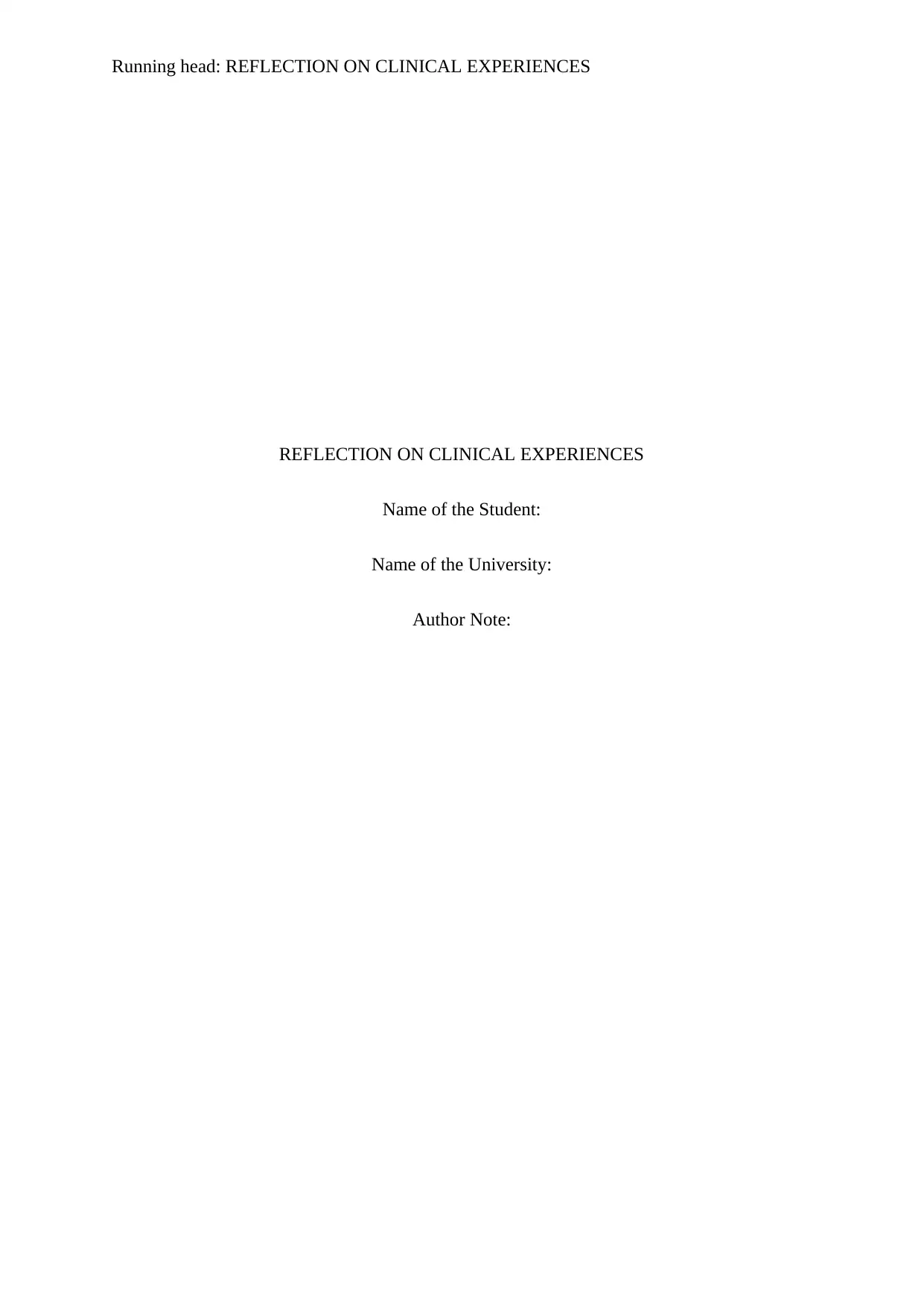
Running head: REFLECTION ON CLINICAL EXPERIENCES
REFLECTION ON CLINICAL EXPERIENCES
Name of the Student:
Name of the University:
Author Note:
REFLECTION ON CLINICAL EXPERIENCES
Name of the Student:
Name of the University:
Author Note:
Paraphrase This Document
Need a fresh take? Get an instant paraphrase of this document with our AI Paraphraser
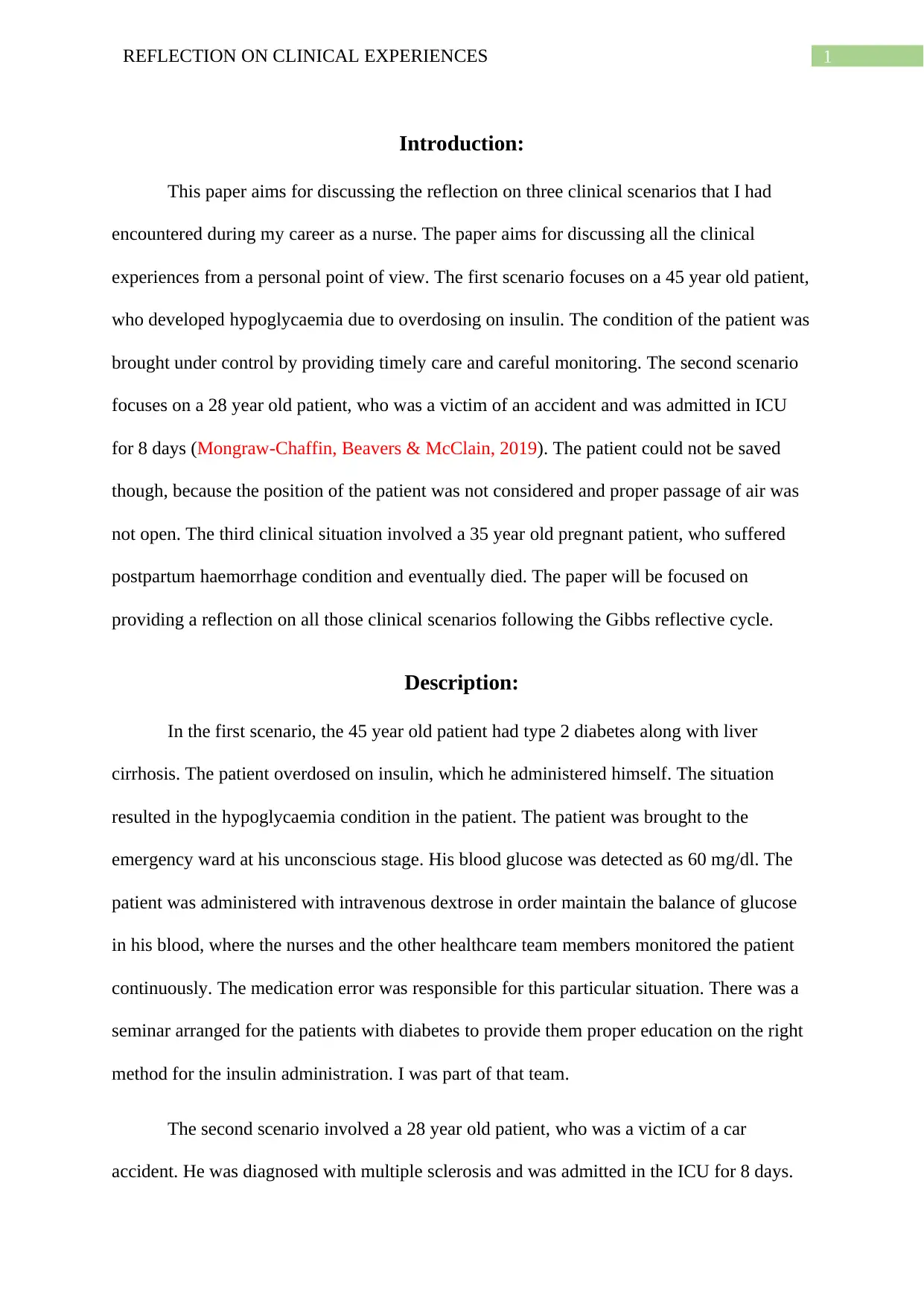
1REFLECTION ON CLINICAL EXPERIENCES
Introduction:
This paper aims for discussing the reflection on three clinical scenarios that I had
encountered during my career as a nurse. The paper aims for discussing all the clinical
experiences from a personal point of view. The first scenario focuses on a 45 year old patient,
who developed hypoglycaemia due to overdosing on insulin. The condition of the patient was
brought under control by providing timely care and careful monitoring. The second scenario
focuses on a 28 year old patient, who was a victim of an accident and was admitted in ICU
for 8 days (Mongraw-Chaffin, Beavers & McClain, 2019). The patient could not be saved
though, because the position of the patient was not considered and proper passage of air was
not open. The third clinical situation involved a 35 year old pregnant patient, who suffered
postpartum haemorrhage condition and eventually died. The paper will be focused on
providing a reflection on all those clinical scenarios following the Gibbs reflective cycle.
Description:
In the first scenario, the 45 year old patient had type 2 diabetes along with liver
cirrhosis. The patient overdosed on insulin, which he administered himself. The situation
resulted in the hypoglycaemia condition in the patient. The patient was brought to the
emergency ward at his unconscious stage. His blood glucose was detected as 60 mg/dl. The
patient was administered with intravenous dextrose in order maintain the balance of glucose
in his blood, where the nurses and the other healthcare team members monitored the patient
continuously. The medication error was responsible for this particular situation. There was a
seminar arranged for the patients with diabetes to provide them proper education on the right
method for the insulin administration. I was part of that team.
The second scenario involved a 28 year old patient, who was a victim of a car
accident. He was diagnosed with multiple sclerosis and was admitted in the ICU for 8 days.
Introduction:
This paper aims for discussing the reflection on three clinical scenarios that I had
encountered during my career as a nurse. The paper aims for discussing all the clinical
experiences from a personal point of view. The first scenario focuses on a 45 year old patient,
who developed hypoglycaemia due to overdosing on insulin. The condition of the patient was
brought under control by providing timely care and careful monitoring. The second scenario
focuses on a 28 year old patient, who was a victim of an accident and was admitted in ICU
for 8 days (Mongraw-Chaffin, Beavers & McClain, 2019). The patient could not be saved
though, because the position of the patient was not considered and proper passage of air was
not open. The third clinical situation involved a 35 year old pregnant patient, who suffered
postpartum haemorrhage condition and eventually died. The paper will be focused on
providing a reflection on all those clinical scenarios following the Gibbs reflective cycle.
Description:
In the first scenario, the 45 year old patient had type 2 diabetes along with liver
cirrhosis. The patient overdosed on insulin, which he administered himself. The situation
resulted in the hypoglycaemia condition in the patient. The patient was brought to the
emergency ward at his unconscious stage. His blood glucose was detected as 60 mg/dl. The
patient was administered with intravenous dextrose in order maintain the balance of glucose
in his blood, where the nurses and the other healthcare team members monitored the patient
continuously. The medication error was responsible for this particular situation. There was a
seminar arranged for the patients with diabetes to provide them proper education on the right
method for the insulin administration. I was part of that team.
The second scenario involved a 28 year old patient, who was a victim of a car
accident. He was diagnosed with multiple sclerosis and was admitted in the ICU for 8 days.
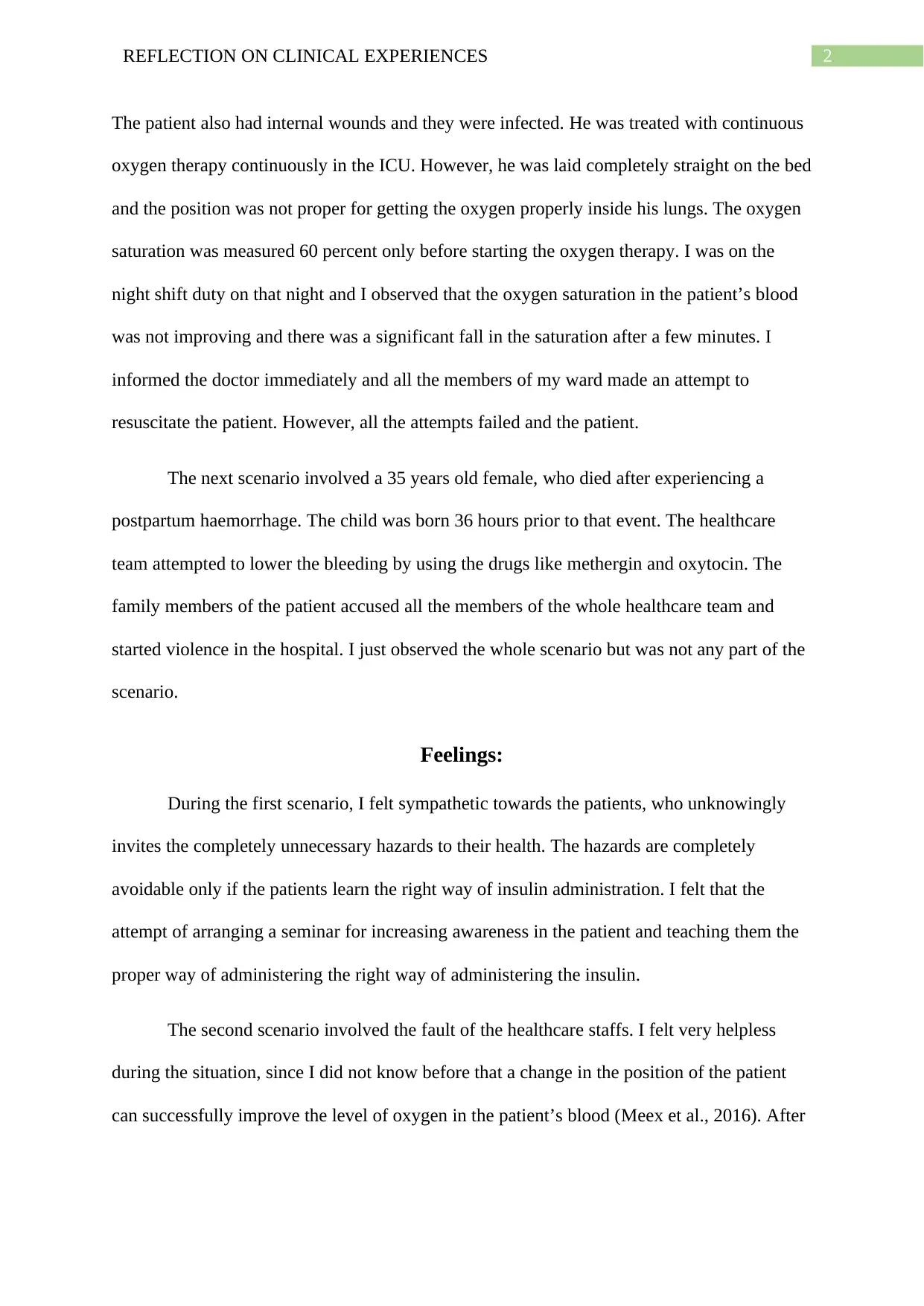
2REFLECTION ON CLINICAL EXPERIENCES
The patient also had internal wounds and they were infected. He was treated with continuous
oxygen therapy continuously in the ICU. However, he was laid completely straight on the bed
and the position was not proper for getting the oxygen properly inside his lungs. The oxygen
saturation was measured 60 percent only before starting the oxygen therapy. I was on the
night shift duty on that night and I observed that the oxygen saturation in the patient’s blood
was not improving and there was a significant fall in the saturation after a few minutes. I
informed the doctor immediately and all the members of my ward made an attempt to
resuscitate the patient. However, all the attempts failed and the patient.
The next scenario involved a 35 years old female, who died after experiencing a
postpartum haemorrhage. The child was born 36 hours prior to that event. The healthcare
team attempted to lower the bleeding by using the drugs like methergin and oxytocin. The
family members of the patient accused all the members of the whole healthcare team and
started violence in the hospital. I just observed the whole scenario but was not any part of the
scenario.
Feelings:
During the first scenario, I felt sympathetic towards the patients, who unknowingly
invites the completely unnecessary hazards to their health. The hazards are completely
avoidable only if the patients learn the right way of insulin administration. I felt that the
attempt of arranging a seminar for increasing awareness in the patient and teaching them the
proper way of administering the right way of administering the insulin.
The second scenario involved the fault of the healthcare staffs. I felt very helpless
during the situation, since I did not know before that a change in the position of the patient
can successfully improve the level of oxygen in the patient’s blood (Meex et al., 2016). After
The patient also had internal wounds and they were infected. He was treated with continuous
oxygen therapy continuously in the ICU. However, he was laid completely straight on the bed
and the position was not proper for getting the oxygen properly inside his lungs. The oxygen
saturation was measured 60 percent only before starting the oxygen therapy. I was on the
night shift duty on that night and I observed that the oxygen saturation in the patient’s blood
was not improving and there was a significant fall in the saturation after a few minutes. I
informed the doctor immediately and all the members of my ward made an attempt to
resuscitate the patient. However, all the attempts failed and the patient.
The next scenario involved a 35 years old female, who died after experiencing a
postpartum haemorrhage. The child was born 36 hours prior to that event. The healthcare
team attempted to lower the bleeding by using the drugs like methergin and oxytocin. The
family members of the patient accused all the members of the whole healthcare team and
started violence in the hospital. I just observed the whole scenario but was not any part of the
scenario.
Feelings:
During the first scenario, I felt sympathetic towards the patients, who unknowingly
invites the completely unnecessary hazards to their health. The hazards are completely
avoidable only if the patients learn the right way of insulin administration. I felt that the
attempt of arranging a seminar for increasing awareness in the patient and teaching them the
proper way of administering the right way of administering the insulin.
The second scenario involved the fault of the healthcare staffs. I felt very helpless
during the situation, since I did not know before that a change in the position of the patient
can successfully improve the level of oxygen in the patient’s blood (Meex et al., 2016). After
⊘ This is a preview!⊘
Do you want full access?
Subscribe today to unlock all pages.

Trusted by 1+ million students worldwide
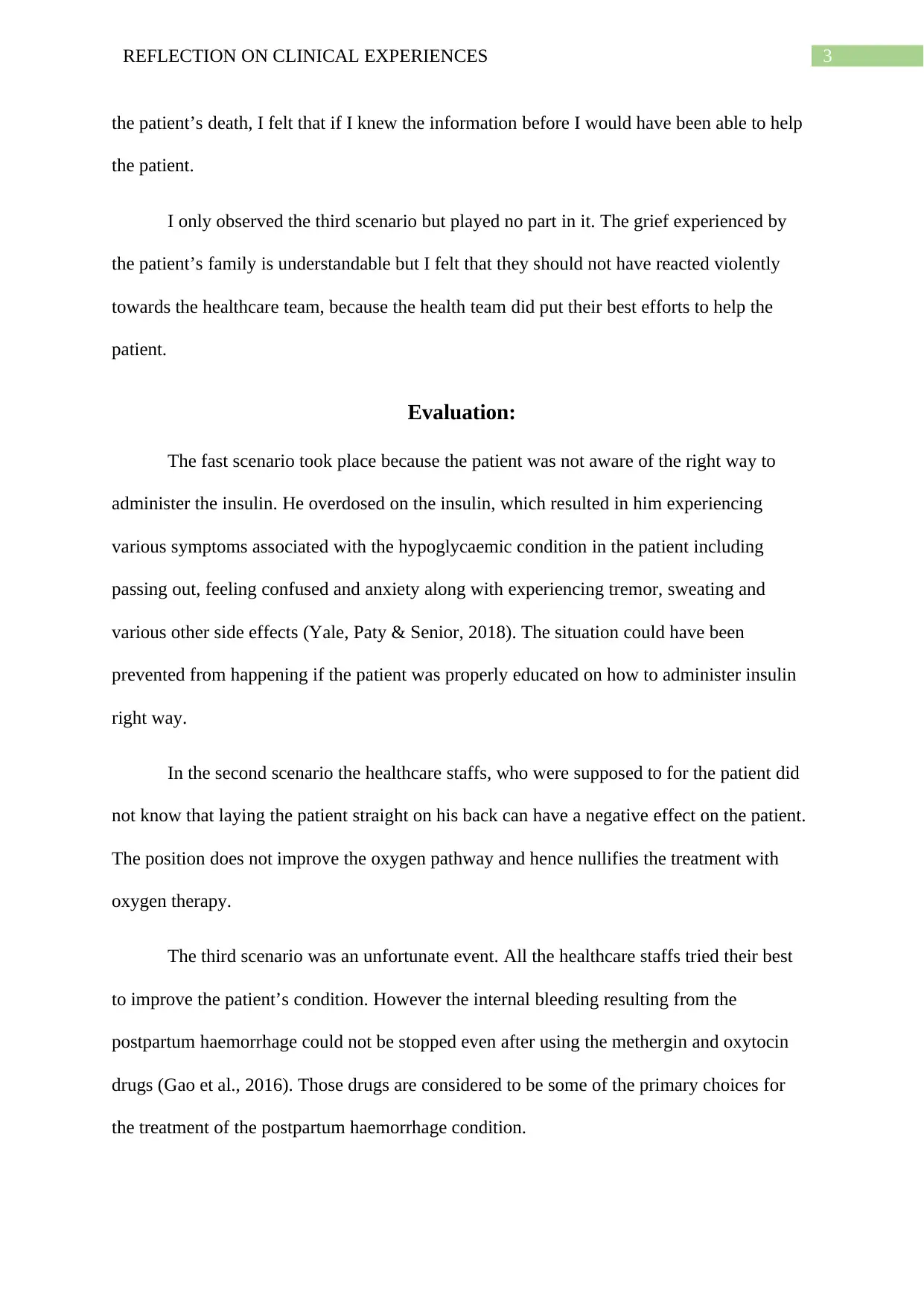
3REFLECTION ON CLINICAL EXPERIENCES
the patient’s death, I felt that if I knew the information before I would have been able to help
the patient.
I only observed the third scenario but played no part in it. The grief experienced by
the patient’s family is understandable but I felt that they should not have reacted violently
towards the healthcare team, because the health team did put their best efforts to help the
patient.
Evaluation:
The fast scenario took place because the patient was not aware of the right way to
administer the insulin. He overdosed on the insulin, which resulted in him experiencing
various symptoms associated with the hypoglycaemic condition in the patient including
passing out, feeling confused and anxiety along with experiencing tremor, sweating and
various other side effects (Yale, Paty & Senior, 2018). The situation could have been
prevented from happening if the patient was properly educated on how to administer insulin
right way.
In the second scenario the healthcare staffs, who were supposed to for the patient did
not know that laying the patient straight on his back can have a negative effect on the patient.
The position does not improve the oxygen pathway and hence nullifies the treatment with
oxygen therapy.
The third scenario was an unfortunate event. All the healthcare staffs tried their best
to improve the patient’s condition. However the internal bleeding resulting from the
postpartum haemorrhage could not be stopped even after using the methergin and oxytocin
drugs (Gao et al., 2016). Those drugs are considered to be some of the primary choices for
the treatment of the postpartum haemorrhage condition.
the patient’s death, I felt that if I knew the information before I would have been able to help
the patient.
I only observed the third scenario but played no part in it. The grief experienced by
the patient’s family is understandable but I felt that they should not have reacted violently
towards the healthcare team, because the health team did put their best efforts to help the
patient.
Evaluation:
The fast scenario took place because the patient was not aware of the right way to
administer the insulin. He overdosed on the insulin, which resulted in him experiencing
various symptoms associated with the hypoglycaemic condition in the patient including
passing out, feeling confused and anxiety along with experiencing tremor, sweating and
various other side effects (Yale, Paty & Senior, 2018). The situation could have been
prevented from happening if the patient was properly educated on how to administer insulin
right way.
In the second scenario the healthcare staffs, who were supposed to for the patient did
not know that laying the patient straight on his back can have a negative effect on the patient.
The position does not improve the oxygen pathway and hence nullifies the treatment with
oxygen therapy.
The third scenario was an unfortunate event. All the healthcare staffs tried their best
to improve the patient’s condition. However the internal bleeding resulting from the
postpartum haemorrhage could not be stopped even after using the methergin and oxytocin
drugs (Gao et al., 2016). Those drugs are considered to be some of the primary choices for
the treatment of the postpartum haemorrhage condition.
Paraphrase This Document
Need a fresh take? Get an instant paraphrase of this document with our AI Paraphraser
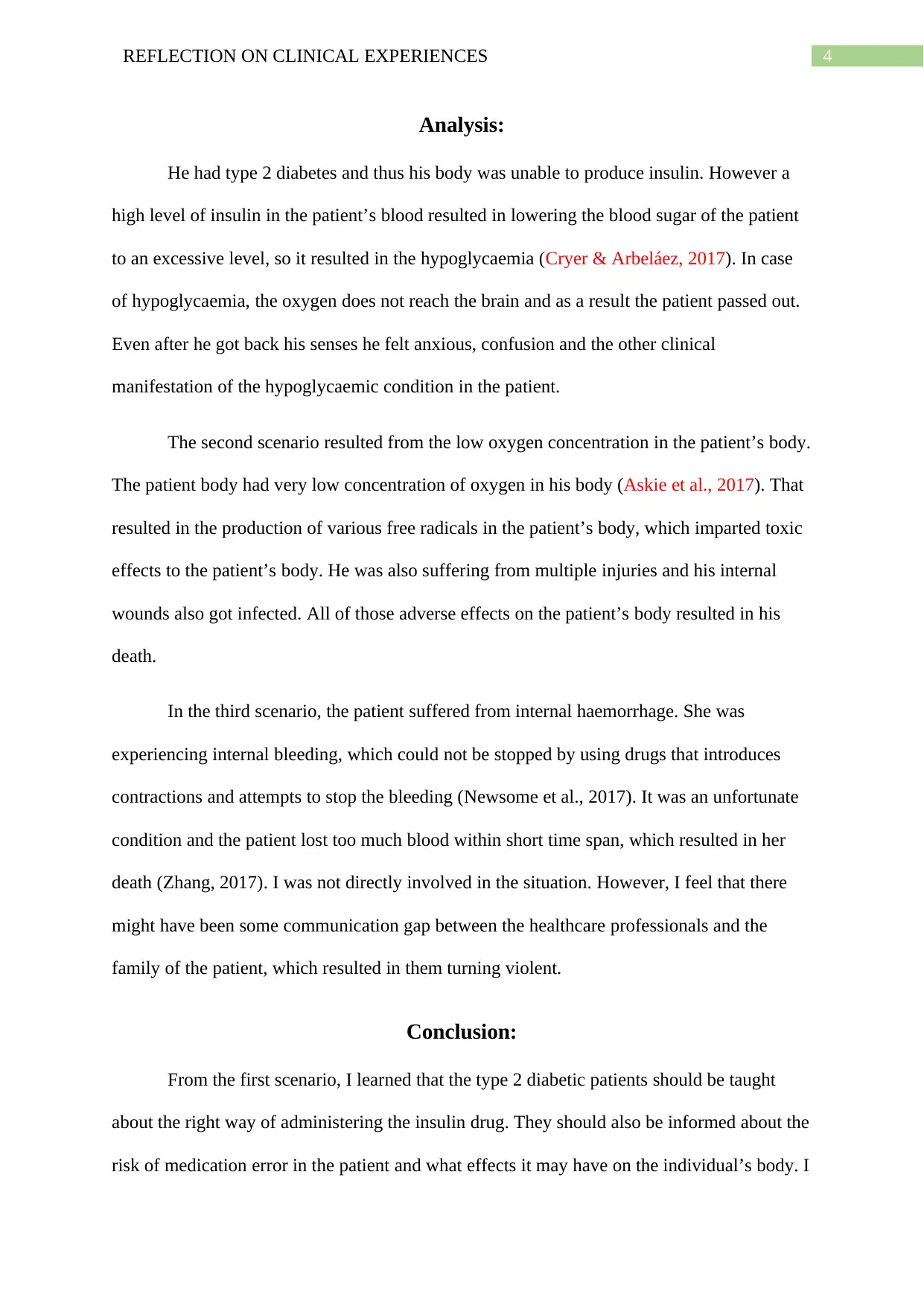
4REFLECTION ON CLINICAL EXPERIENCES
Analysis:
He had type 2 diabetes and thus his body was unable to produce insulin. However a
high level of insulin in the patient’s blood resulted in lowering the blood sugar of the patient
to an excessive level, so it resulted in the hypoglycaemia (Cryer & Arbeláez, 2017). In case
of hypoglycaemia, the oxygen does not reach the brain and as a result the patient passed out.
Even after he got back his senses he felt anxious, confusion and the other clinical
manifestation of the hypoglycaemic condition in the patient.
The second scenario resulted from the low oxygen concentration in the patient’s body.
The patient body had very low concentration of oxygen in his body (Askie et al., 2017). That
resulted in the production of various free radicals in the patient’s body, which imparted toxic
effects to the patient’s body. He was also suffering from multiple injuries and his internal
wounds also got infected. All of those adverse effects on the patient’s body resulted in his
death.
In the third scenario, the patient suffered from internal haemorrhage. She was
experiencing internal bleeding, which could not be stopped by using drugs that introduces
contractions and attempts to stop the bleeding (Newsome et al., 2017). It was an unfortunate
condition and the patient lost too much blood within short time span, which resulted in her
death (Zhang, 2017). I was not directly involved in the situation. However, I feel that there
might have been some communication gap between the healthcare professionals and the
family of the patient, which resulted in them turning violent.
Conclusion:
From the first scenario, I learned that the type 2 diabetic patients should be taught
about the right way of administering the insulin drug. They should also be informed about the
risk of medication error in the patient and what effects it may have on the individual’s body. I
Analysis:
He had type 2 diabetes and thus his body was unable to produce insulin. However a
high level of insulin in the patient’s blood resulted in lowering the blood sugar of the patient
to an excessive level, so it resulted in the hypoglycaemia (Cryer & Arbeláez, 2017). In case
of hypoglycaemia, the oxygen does not reach the brain and as a result the patient passed out.
Even after he got back his senses he felt anxious, confusion and the other clinical
manifestation of the hypoglycaemic condition in the patient.
The second scenario resulted from the low oxygen concentration in the patient’s body.
The patient body had very low concentration of oxygen in his body (Askie et al., 2017). That
resulted in the production of various free radicals in the patient’s body, which imparted toxic
effects to the patient’s body. He was also suffering from multiple injuries and his internal
wounds also got infected. All of those adverse effects on the patient’s body resulted in his
death.
In the third scenario, the patient suffered from internal haemorrhage. She was
experiencing internal bleeding, which could not be stopped by using drugs that introduces
contractions and attempts to stop the bleeding (Newsome et al., 2017). It was an unfortunate
condition and the patient lost too much blood within short time span, which resulted in her
death (Zhang, 2017). I was not directly involved in the situation. However, I feel that there
might have been some communication gap between the healthcare professionals and the
family of the patient, which resulted in them turning violent.
Conclusion:
From the first scenario, I learned that the type 2 diabetic patients should be taught
about the right way of administering the insulin drug. They should also be informed about the
risk of medication error in the patient and what effects it may have on the individual’s body. I
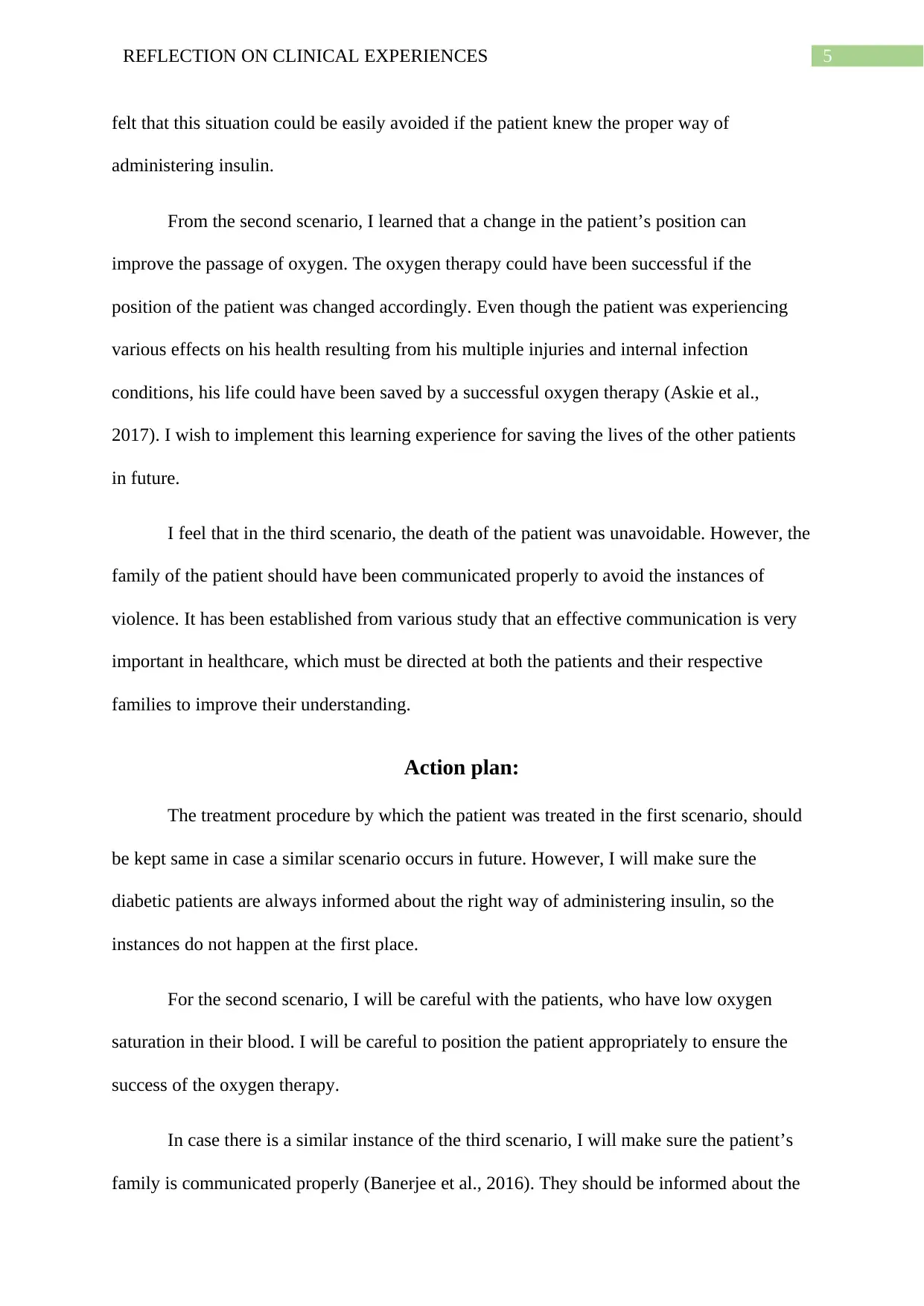
5REFLECTION ON CLINICAL EXPERIENCES
felt that this situation could be easily avoided if the patient knew the proper way of
administering insulin.
From the second scenario, I learned that a change in the patient’s position can
improve the passage of oxygen. The oxygen therapy could have been successful if the
position of the patient was changed accordingly. Even though the patient was experiencing
various effects on his health resulting from his multiple injuries and internal infection
conditions, his life could have been saved by a successful oxygen therapy (Askie et al.,
2017). I wish to implement this learning experience for saving the lives of the other patients
in future.
I feel that in the third scenario, the death of the patient was unavoidable. However, the
family of the patient should have been communicated properly to avoid the instances of
violence. It has been established from various study that an effective communication is very
important in healthcare, which must be directed at both the patients and their respective
families to improve their understanding.
Action plan:
The treatment procedure by which the patient was treated in the first scenario, should
be kept same in case a similar scenario occurs in future. However, I will make sure the
diabetic patients are always informed about the right way of administering insulin, so the
instances do not happen at the first place.
For the second scenario, I will be careful with the patients, who have low oxygen
saturation in their blood. I will be careful to position the patient appropriately to ensure the
success of the oxygen therapy.
In case there is a similar instance of the third scenario, I will make sure the patient’s
family is communicated properly (Banerjee et al., 2016). They should be informed about the
felt that this situation could be easily avoided if the patient knew the proper way of
administering insulin.
From the second scenario, I learned that a change in the patient’s position can
improve the passage of oxygen. The oxygen therapy could have been successful if the
position of the patient was changed accordingly. Even though the patient was experiencing
various effects on his health resulting from his multiple injuries and internal infection
conditions, his life could have been saved by a successful oxygen therapy (Askie et al.,
2017). I wish to implement this learning experience for saving the lives of the other patients
in future.
I feel that in the third scenario, the death of the patient was unavoidable. However, the
family of the patient should have been communicated properly to avoid the instances of
violence. It has been established from various study that an effective communication is very
important in healthcare, which must be directed at both the patients and their respective
families to improve their understanding.
Action plan:
The treatment procedure by which the patient was treated in the first scenario, should
be kept same in case a similar scenario occurs in future. However, I will make sure the
diabetic patients are always informed about the right way of administering insulin, so the
instances do not happen at the first place.
For the second scenario, I will be careful with the patients, who have low oxygen
saturation in their blood. I will be careful to position the patient appropriately to ensure the
success of the oxygen therapy.
In case there is a similar instance of the third scenario, I will make sure the patient’s
family is communicated properly (Banerjee et al., 2016). They should be informed about the
⊘ This is a preview!⊘
Do you want full access?
Subscribe today to unlock all pages.

Trusted by 1+ million students worldwide
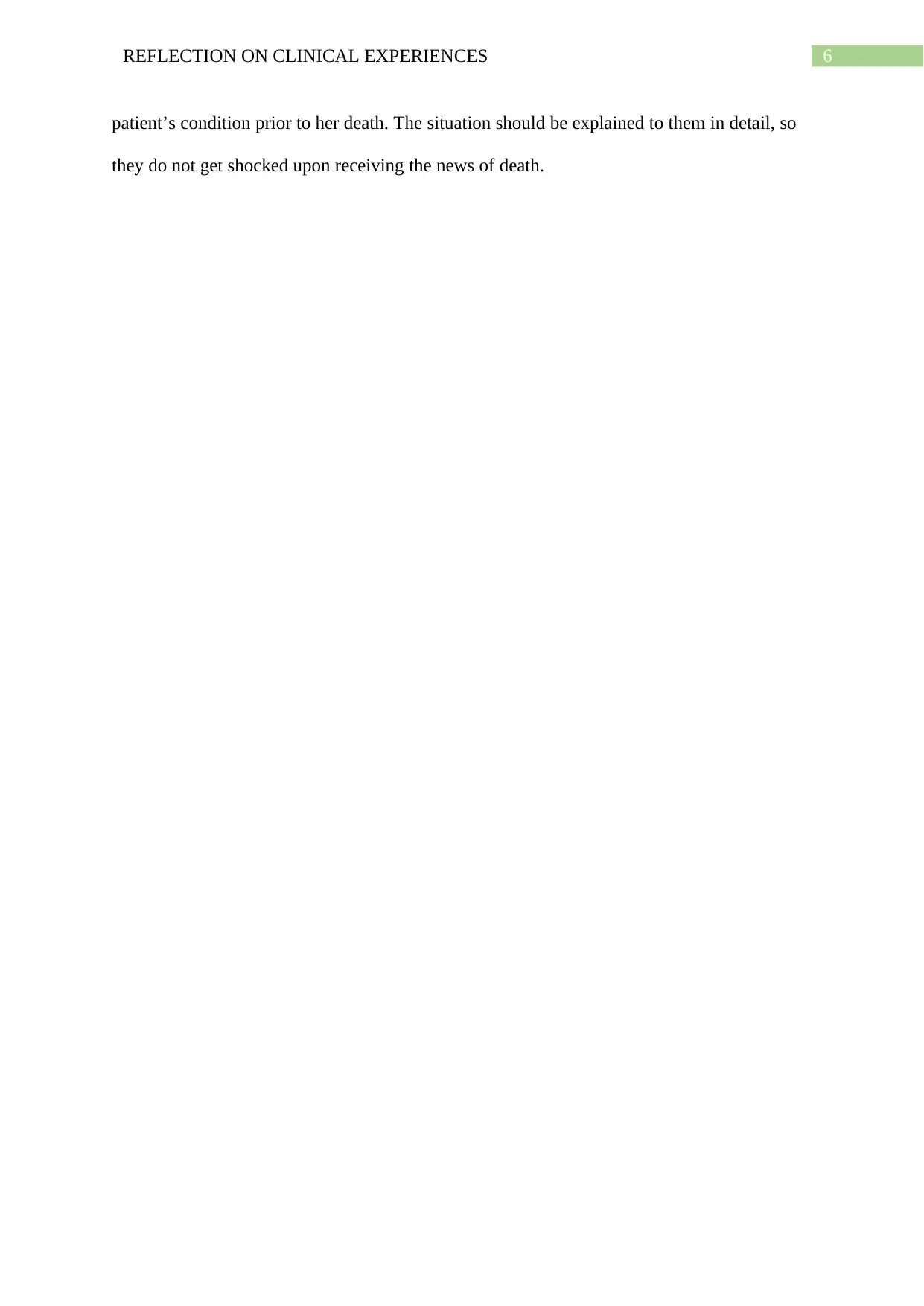
6REFLECTION ON CLINICAL EXPERIENCES
patient’s condition prior to her death. The situation should be explained to them in detail, so
they do not get shocked upon receiving the news of death.
patient’s condition prior to her death. The situation should be explained to them in detail, so
they do not get shocked upon receiving the news of death.
Paraphrase This Document
Need a fresh take? Get an instant paraphrase of this document with our AI Paraphraser
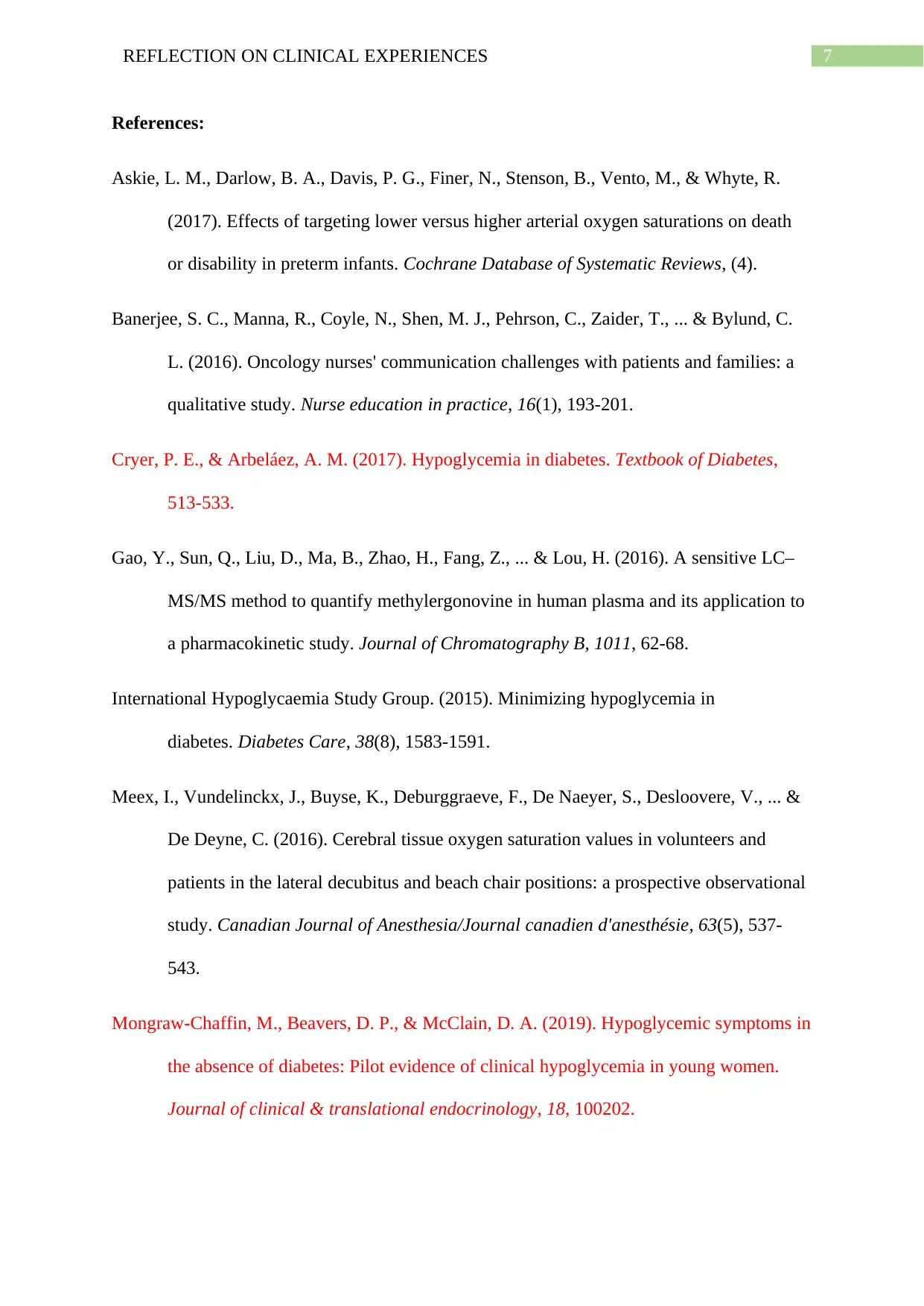
7REFLECTION ON CLINICAL EXPERIENCES
References:
Askie, L. M., Darlow, B. A., Davis, P. G., Finer, N., Stenson, B., Vento, M., & Whyte, R.
(2017). Effects of targeting lower versus higher arterial oxygen saturations on death
or disability in preterm infants. Cochrane Database of Systematic Reviews, (4).
Banerjee, S. C., Manna, R., Coyle, N., Shen, M. J., Pehrson, C., Zaider, T., ... & Bylund, C.
L. (2016). Oncology nurses' communication challenges with patients and families: a
qualitative study. Nurse education in practice, 16(1), 193-201.
Cryer, P. E., & Arbeláez, A. M. (2017). Hypoglycemia in diabetes. Textbook of Diabetes,
513-533.
Gao, Y., Sun, Q., Liu, D., Ma, B., Zhao, H., Fang, Z., ... & Lou, H. (2016). A sensitive LC–
MS/MS method to quantify methylergonovine in human plasma and its application to
a pharmacokinetic study. Journal of Chromatography B, 1011, 62-68.
International Hypoglycaemia Study Group. (2015). Minimizing hypoglycemia in
diabetes. Diabetes Care, 38(8), 1583-1591.
Meex, I., Vundelinckx, J., Buyse, K., Deburggraeve, F., De Naeyer, S., Desloovere, V., ... &
De Deyne, C. (2016). Cerebral tissue oxygen saturation values in volunteers and
patients in the lateral decubitus and beach chair positions: a prospective observational
study. Canadian Journal of Anesthesia/Journal canadien d'anesthésie, 63(5), 537-
543.
Mongraw-Chaffin, M., Beavers, D. P., & McClain, D. A. (2019). Hypoglycemic symptoms in
the absence of diabetes: Pilot evidence of clinical hypoglycemia in young women.
Journal of clinical & translational endocrinology, 18, 100202.
References:
Askie, L. M., Darlow, B. A., Davis, P. G., Finer, N., Stenson, B., Vento, M., & Whyte, R.
(2017). Effects of targeting lower versus higher arterial oxygen saturations on death
or disability in preterm infants. Cochrane Database of Systematic Reviews, (4).
Banerjee, S. C., Manna, R., Coyle, N., Shen, M. J., Pehrson, C., Zaider, T., ... & Bylund, C.
L. (2016). Oncology nurses' communication challenges with patients and families: a
qualitative study. Nurse education in practice, 16(1), 193-201.
Cryer, P. E., & Arbeláez, A. M. (2017). Hypoglycemia in diabetes. Textbook of Diabetes,
513-533.
Gao, Y., Sun, Q., Liu, D., Ma, B., Zhao, H., Fang, Z., ... & Lou, H. (2016). A sensitive LC–
MS/MS method to quantify methylergonovine in human plasma and its application to
a pharmacokinetic study. Journal of Chromatography B, 1011, 62-68.
International Hypoglycaemia Study Group. (2015). Minimizing hypoglycemia in
diabetes. Diabetes Care, 38(8), 1583-1591.
Meex, I., Vundelinckx, J., Buyse, K., Deburggraeve, F., De Naeyer, S., Desloovere, V., ... &
De Deyne, C. (2016). Cerebral tissue oxygen saturation values in volunteers and
patients in the lateral decubitus and beach chair positions: a prospective observational
study. Canadian Journal of Anesthesia/Journal canadien d'anesthésie, 63(5), 537-
543.
Mongraw-Chaffin, M., Beavers, D. P., & McClain, D. A. (2019). Hypoglycemic symptoms in
the absence of diabetes: Pilot evidence of clinical hypoglycemia in young women.
Journal of clinical & translational endocrinology, 18, 100202.
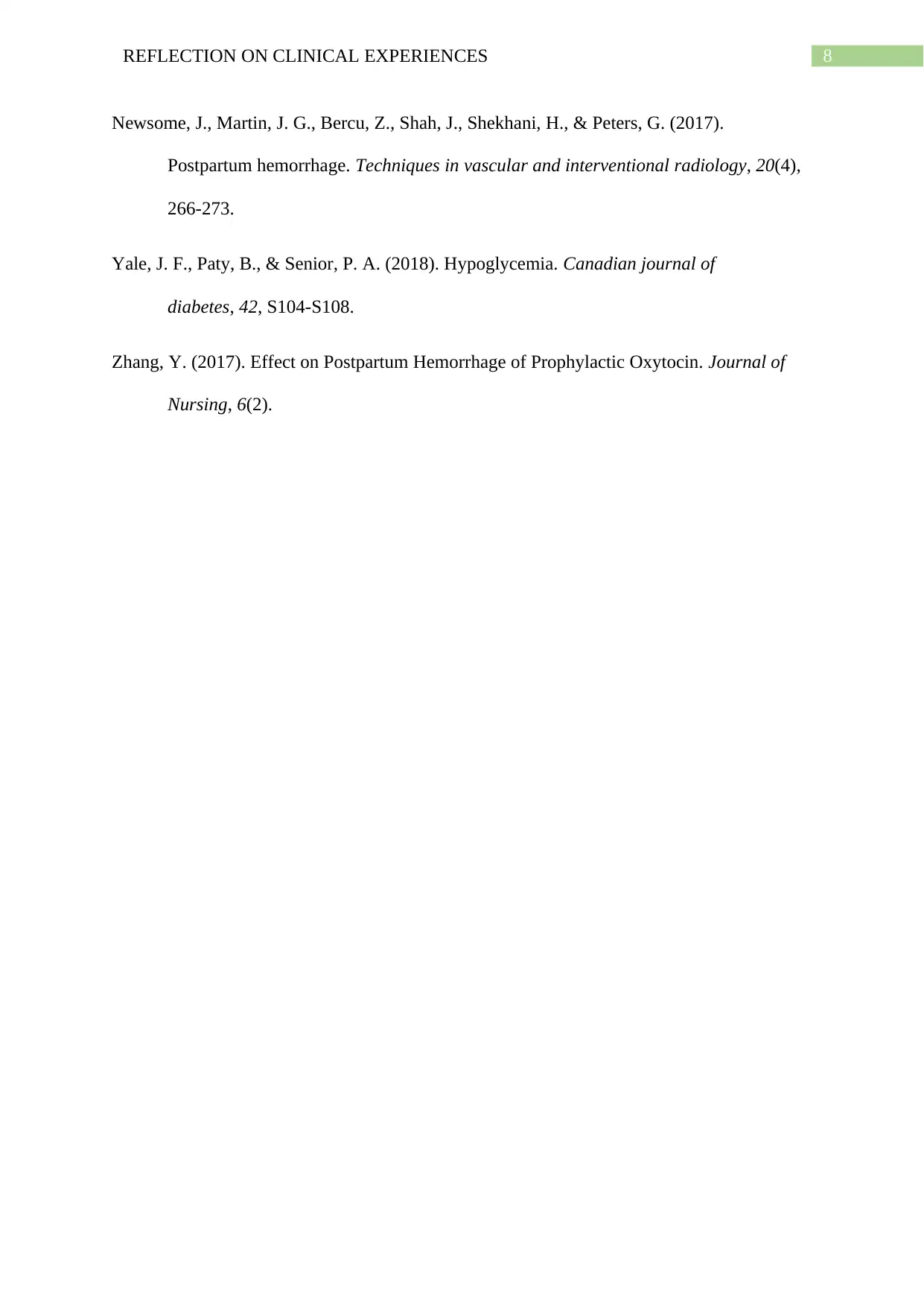
8REFLECTION ON CLINICAL EXPERIENCES
Newsome, J., Martin, J. G., Bercu, Z., Shah, J., Shekhani, H., & Peters, G. (2017).
Postpartum hemorrhage. Techniques in vascular and interventional radiology, 20(4),
266-273.
Yale, J. F., Paty, B., & Senior, P. A. (2018). Hypoglycemia. Canadian journal of
diabetes, 42, S104-S108.
Zhang, Y. (2017). Effect on Postpartum Hemorrhage of Prophylactic Oxytocin. Journal of
Nursing, 6(2).
Newsome, J., Martin, J. G., Bercu, Z., Shah, J., Shekhani, H., & Peters, G. (2017).
Postpartum hemorrhage. Techniques in vascular and interventional radiology, 20(4),
266-273.
Yale, J. F., Paty, B., & Senior, P. A. (2018). Hypoglycemia. Canadian journal of
diabetes, 42, S104-S108.
Zhang, Y. (2017). Effect on Postpartum Hemorrhage of Prophylactic Oxytocin. Journal of
Nursing, 6(2).
⊘ This is a preview!⊘
Do you want full access?
Subscribe today to unlock all pages.

Trusted by 1+ million students worldwide
1 out of 9
Related Documents
Your All-in-One AI-Powered Toolkit for Academic Success.
+13062052269
info@desklib.com
Available 24*7 on WhatsApp / Email
![[object Object]](/_next/static/media/star-bottom.7253800d.svg)
Unlock your academic potential
Copyright © 2020–2025 A2Z Services. All Rights Reserved. Developed and managed by ZUCOL.




